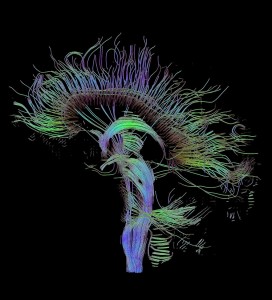Grey is the new White? Not in the brain!

Figure 1: Reconstructed white matter fiber tracts of the brain, brainstem, and spinal cord. View through the mid-sagittal plane.
Rendering is work of Thomas Schultz, using a modified version of the BioTensor application developed at the University of Utah. The dataset is courtesy of Gordon Kindlmann at the Scientific Computing and Imaging Institute, University of Utah, and Andrew Alexander, W.M. Keck Laboratory for Functional Brain Imaging and Behaviour, University of Wisconsin, Madison.
White and Grey Matter
Brain tissue is composed primarily of neurons and glia. Neurons are cells that transmit information throughout the body. As described in Neuron a Superhighway!, a neuron is composed of dendrites, a cell body, and an axon. Glial cells, on the other hand, are broadly defined as non-neuronal cells that maintain the local environment. Some glia maintain homeostasis (equilibrium between interdependent elements), others respond to injury, and a third class actually helps neurons relay information.
White Matter
White matter is composed of long myelinated axons that connect areas of the brain. Myelin is a fatty sheet produced by specific glial cells. It surrounds and insulates axons giving the axons a whitish appearance. When bundled together, long myelinated axons form white matter tracts. These tracts relay information from one area of the brain to other and between the brain, spinal cord, and periphery. The brain is composed of a number of large white matter tracts including the corpus callosum and the corticospinal tract. The corpus callosum connects the right and left sides of the brain. The corticospinal tract carries motor commands from the motor cortex to the spinal cord. The spinal cord then sends axons (nerves) to muscle fibers to produce body movement. Remember though that each axon is connected to a cell body, and the cell body is responsible for keeping the whole cell alive and healthy.
Grey Matter
Grey matter is essentially everything else in the brain and spinal cord. It is composed of neuron cell bodies, the neuropil (dendrites and short myelinated and unmyelinated axons), glial cells, and capillaries. While white matter transmits information, grey matter collects and modifies that information. In the grey matter, neurons receive information distally through the white matter tracts and locally from nearby neurons. This information can be modified depending on the neuron’s intrinsic properties. Local interactions with neurons and glia can also alter how a single neuron or the entire network functions. It is therefore important to keep the local environment tightly controlled. In the brain, the cerebral cortex, basal ganglia, and hypothalamus are examples of grey matter areas. Regions of grey matter can have very specific functions. The motor cortex, for instance, has designated regions dedicated to moving specific fingers.
